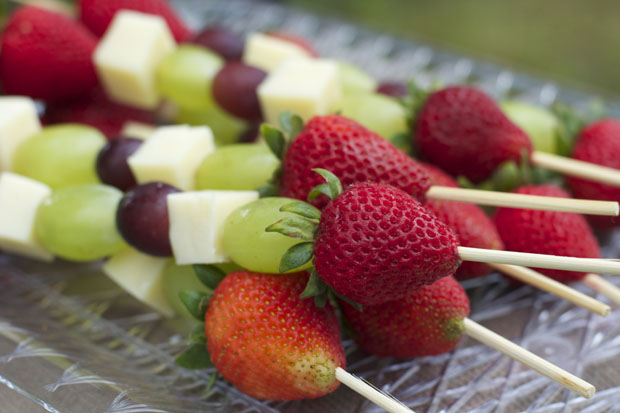Creative After School Snacks
29 Aug 2016
When your kids come home from school with rumbling tummies, follow these nutrition tips to steer them away from the bag of chips or cookies
By EDNA COX RICE, RD, CSG, LD

Most people need to eat every three to four hours to avoid getting too hungry; this is especially true for growing kids. Waiting much longer often leads to overeating and gorging on easy to grab processed foods.
Active, growing kids and teens need to include three meals and two to three snacks daily to help them stay energized all day long. Research indicates that all individuals who include planned snacks tend to have healthier diets. Our bodies are better able to absorb and use the nutrients when meals plus snacks are eaten. Here are some easy ideas for delicious and nutritious snacks that your children and you will enjoy!
After School Activities Involve your kids in planning smart snacks to enjoy after school. Let them help you get organized in the kitchen. Keep healthful staples on hand, such as whole wheat, low-fat crackers; whole wheat mini bagels; fat-free or low-fat cheese; and nonfat yogurt.
Prepare fruits and veggies in advance to save time. Keep healthy options visible and easily accessible. Place a bowl of fruit on the counter, and keep the pre-sliced veggies in the front of the frig, so they’re easy to grab and go. These simple strategies can make smart snacking a breeze.
Clean up Your Snacks Forget processed foods, they’re generally laden with sugar, salt, fat, or all three. Instead, focus on snacking on whole foods. Whole foods not only contain vitamins and minerals, but also important antioxidants and phytochemicals that help boost your child’s immune system. You’ll teach your family to avoid spending snack calories on “empty” foods, and they’ll learn to make every bite count nutritionally.
As an added advantage, nutrient dense whole foods are generally less costly than most processed foods. Be smart, use minimally processed whole grains, vegetables, fruit, and nonfat milk products. For example, substitute crispy veggie rounds in place of salty, high calorie chips.
Size Matters Think twice before you or your child select the “Supersized” deal; you always end up with more sugar, salt, fat and empty calories. Depending on your child’s age and activity level, they usually don’t need to limit calories, as long as they’re physically active. It helps kids understand and establish healthy lifelong eating habits if you teach them about portion sizes.
If you and your child are not very active, it may be smart to limit portions for certain snack items. Help them make smart choices and snack sensibly. If weight or activity is a challenge for any family member, it may be beneficial to spend a little time daily or weekly pre-portioning your snacks; you’ll not only save time, but you’ll slash unnecessary calories as well.
Grab and Go Ravenous kids may need a snack in the car on the ride home, or on the way to an athletic event. Pack it, stuff it, but always bring food with you. Pack apples, bananas, baby carrots and whole grain crackers in your purse, backpack, briefcase, or gym bag. Keep a snack-size bag of almonds, a box of raisins, or an energy bar handy. Having these smart options readily available prevents stopping at the nearest fast-food drive-through for fries and a sugary beverage.
Your child will perform better and last longer during an athletic event if their snack includes protein and complex carbohydrates. Peanut butter on whole wheat bread, cheese and whole grain crackers, fruit and cheese are easy to pack for the car and make smart pre-event snacks for kids.
Drink Up Are you really having a snack attack? Or are you thirsty? We often confuse the sense of thirst with feeling hungry. Drinking water, juice, milk or any calorie-free beverage before a meal or snack can curb your appetite, and you can dramatically reduce unwanted sugar intake just by drinking more water versus sweet tea or sodas. Since we all need at least six to eight glasses of water daily, smart snacks include water or some “non-sugary” beverage.
Kids involved in athletic events need to be sure to properly hydrate before, during, and after practice and the actual events. Water is always the smartest choice.
Crave Crunchy If crunchy snacks are the crave and the rave for your family, rather than reaching for a bag of chips, try a smart strategy: lose the chips and add veggies that crunch or air-popped corn. Not ready to completely give up the chips? Try baked chips, veggie chips, or pre-portioned servings. A smaller bag of chips may save two to three hundred calories every time you crave the crunch.
Smart Sweets Teach kids to tame their sweet tooth with naturally sweet foods and let them try these sweet sensations. Fruit skewers, using their favorite or sneak a new fruit for them to try on the skewer, dipped in dark chocolate. A fall favorite, sliced apples with caramel sauce. Surprisingly low in calories and high in nutrition, an eight-ounce glass of chocolate milk; chocolate soy or almond milk contains even less calories than regular chocolate milk.
Load up on Fiber Increasing daily fiber intake is challenging at all ages. High fiber foods are frequently lower in calories and are always high in nutrition. Kids need fiber to help support a healthy digestive system. High fiber foods at meals and snacks can help you feel full and satisfied. Fruits and vegetables are among the best sources of fiber; they’re convenient and are smart, tasty snack options.
SMART SNACKS
Easy to make, easy to pack, tasty and nutritious!
Fruit & Cheese Skewers – any mix of fruit and cheese can be used; kids can spear their own.
Smoothie Pops – whip up a batch of your kid’s favorite smoothie, then freeze in popsicle molds; a great way to add fruit and veggies to your kid’s diet.
Apple Cookies – slice apples in rounds; spread on a nut butter, top with dark chocolate chips. A healthy cookie treat.
Roast Chickpeas – drain canned chickpeas; toss with cinnamon, ranch or BBQ seasoning; spread on a cookie sheet and bake at 375° for ~ 10 minutes or until crunchy.
Sweet Potato Fries – toss sliced sweet potatoes in a cinnamon-sugar mix; lightly coat a cookie sheet with olive oil; spread sweet potatoes evenly on cookie sheet; bake at 375° for ~ 15 minutes.
Pretzels & Peanut Butter Dippers – dip whole wheat pretzel rods in peanut butter or any nut butter. Fun for kids to use these dippers.
Hummus & Veggies – classic hummus (homemade or your favorite store version) with baby carrots or cucumber, squash, or zucchini rounds. Another great way to get kids to eat their veggies.
Fruit & Yogurt – mix your kid’s favorite fruit – strawberries, blueberries, bananas – with nonfat yogurt for a calcium boost; for an added protein boost go Greek. Greek yogurt has twice the protein than most other yogurts.
Brown Rice Pudding – save leftover brown rice from dinner; add nonfat milk or fortified vanilla soy milk; spice it up with more vanilla flavoring, cinnamon, or nutmeg. Be extra smart and add chopped fresh or dried fruit.
PB&J – add a healthy twist by using a multi-grain bread, bagel or crackers; add crunchy peanut or other nut butters; top with fresh fruit or a reduced sugar fruit spread. This classic is always a kids’ favorite.











